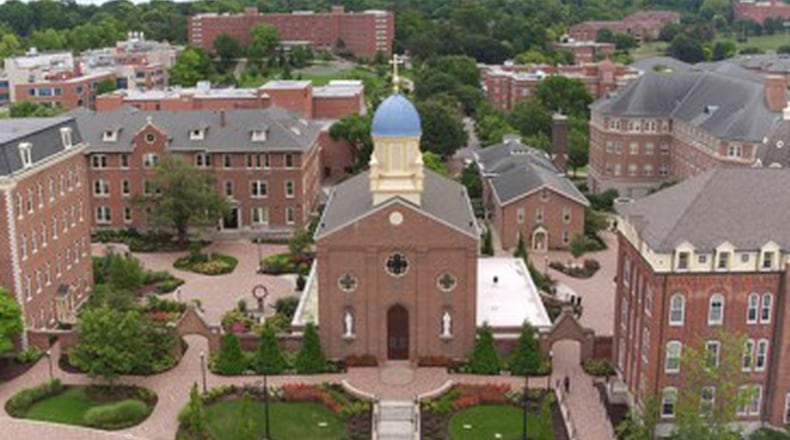“Our entire community is working hard to make a University of Dayton education accessible for all students," said Jason Reinoehl, vice president for strategic enrollment management.
Since 2011, UD has increased its underrepresented student population by 86%, he said. Its overall fall 2020 enrollment is 11,678 students.
Native Americans/Pacific Islanders, Blacks and Hispanics, the three groups that saw the steepest enrollment declines nationwide, had the biggest gains at UD this year, based on each area school’s ethnicity data that the Dayton Daily News examined. Compared to fall 2019, UD increased its number of Native Americans/Pacific Islanders students from five to eight ― a 60% increase ― enrollment of Black students increased by 26% and Hispanics by 16.2%.
In all, a record 19% of the university’s freshman class comes from underrepresented racial and ethnic groups, the university said.
In comparison to institutions nationwide, Native Americans’ undergraduate enrollment decline by 9.6%, followed by declines in Black students of 7.5% and in Hispanic students of 5.4%. White enrollment dropped to 6.6%, according to a National Student Clearinghouse Research Center’s latest study, released on Nov. 11. The group’s latest college enrollment data is as of Oct. 22, and is based on 13.6 million enrolled students from 76% of postsecondary institutions that report to the Clearinghouse.
Overall college enrollment dipped 4.4% across the country this fall, the Clearinghouse said, noting that the COVID-19 pandemic is to blame for the decline.
Enrollment declines among people of color are higher because they are more likely to attend community colleges, said Doug Shapiro, Clearinghouse executive director.
Nationwide community colleges saw the sharpest drop in overall enrollment of 9.4% compared to their pre-pandemic loss rate of 1% between fall 2018 and 2019, according to the Clearinghouse. That’s because the nation’s institutions have had to switch to virtual learning as a result of the pandemic, and many community college programs are not as easy to convert online as they are for four-year schools, he said.
Although colleges across the state do a good job of reaching out to minority and ethnic groups, the COVID-19 pandemic made recruiting difficult this year, said Bruce Johnson, president and CEO of the Inter-University Council of Ohio.
“To the extent that education is a great equalizer for all people, it’s even more of an equalizer for minority populations,” Johnson said. “So, they have the most to gain, and therefore, the most to lose by not entering college.”
Locally, Sinclair Community College’s overall enrollment of 18,666 is relatively flat compared to last fall. However, the school’s Native Hawaiian/Pacific Island student population dipped by 20.5%, the most among all minority groups, compared to fall 2019. Black student enrollment declined 6%, according to school officials.
The college’s Hispanic enrollment increased by 1.3% while American Indian/Alaska Natives declined by 0.7%. Nearly 63% of the college’s students did not report their race or their ethnicity was unknown, officials said.
Wright State’s overall fall enrollment of 12,234 exceeded officials’ expectations, as they thought the coronavirus would have more of an impact. This year’s overall minority student population ― 21.6% ― remained nearly flat, compared to fall 2019. Black student enrollment, the school’s largest minority group, dipped slightly to 9.7% from 10% last year, according to school data.
Cedarville University added 170 new students, bringing its total enrollment this year to 4,550, a 3.8% increase over last year, according to the university. However, the number of minority undergraduate students went from 10% last year to 9.9% this fall, the school said. While the number of Black students increased, 22 fewer Hispanic undergraduates enrolled this fall, the university said.
Antioch College saw the biggest percentage increase in undergraduate enrollment among the area’s private institutions. The school added 50 new students this year, bringing its total to 116 ― a 22% increase, school officials said. The number of new students include eight Black students and seven more Hispanics.
The number of Native Americans and students with two or more races declined, and the number of Asian students remained the same, the school said.
Central State and Wilberforce universities, the area’s only Historically Black Colleges and Universities, experienced overall enrollment declines as well. CSU, where Black students are 90% of the school’s total population, saw a nearly 9% dip in enrollment for traditional undergraduate students, school officials said.
Wilberforce, which has only online instructions this fall because of the pandemic, has 131 fewer students, compared to last year, officials said.
It will likely be difficult for the nation’s colleges to recover from the enrollment declines next year, Shapiro said.
“State budgets are very constrained by the recession, and that affects the community colleges more than the four year institution. So it’d be harder for them to expand their capacity next year,” he said.
About the Author

